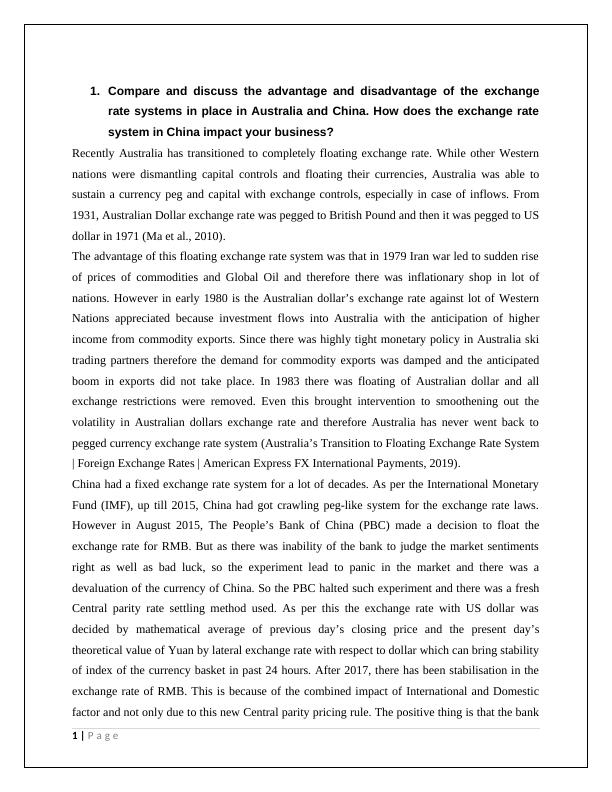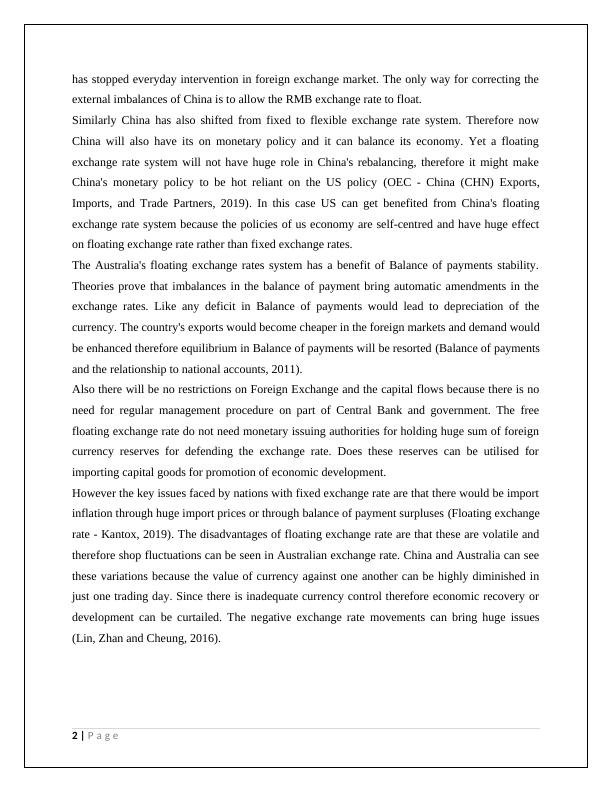Exchange Rate Systems in Australia and China, Profit Repatriation and Funding Options for Business Growth in China
Added on 2023-04-22
9 Pages3384 Words329 Views
Table of Contents
1. Compare and discuss the advantage and disadvantage of the exchange rate systems in place in
Australia and China. How does the exchange rate system in China impact your business?........................1
2. Explain how would you bring back profits from your business back to Australia and briefly discuss
the tax implication (both China and Australia) on your profit, if any...........................................................3
3. Assuming that there is a repeat of Asia Financial Crisis that took place in the late 1990 and currency
across Asia is fast depreciating....................................................................................................................3
4. The business is now growing ................................................................................................................4
5. Currency to raise funds........................................................................................................................4
6. Raising AUD to fund growth of business in China by a local loan........................................................5
7. Other ways of growing business in case of issues in raising necessary capital for funding expansion.5
References...................................................................................................................................................7
Name:
Student ID:
1. Compare and discuss the advantage and disadvantage of the exchange rate systems in place in
Australia and China. How does the exchange rate system in China impact your business?........................1
2. Explain how would you bring back profits from your business back to Australia and briefly discuss
the tax implication (both China and Australia) on your profit, if any...........................................................3
3. Assuming that there is a repeat of Asia Financial Crisis that took place in the late 1990 and currency
across Asia is fast depreciating....................................................................................................................3
4. The business is now growing ................................................................................................................4
5. Currency to raise funds........................................................................................................................4
6. Raising AUD to fund growth of business in China by a local loan........................................................5
7. Other ways of growing business in case of issues in raising necessary capital for funding expansion.5
References...................................................................................................................................................7
Name:
Student ID:

1. Compare and discuss the advantage and disadvantage of the exchange
rate systems in place in Australia and China. How does the exchange rate
system in China impact your business?
Recently Australia has transitioned to completely floating exchange rate. While other Western
nations were dismantling capital controls and floating their currencies, Australia was able to
sustain a currency peg and capital with exchange controls, especially in case of inflows. From
1931, Australian Dollar exchange rate was pegged to British Pound and then it was pegged to US
dollar in 1971 (Ma et al., 2010).
The advantage of this floating exchange rate system was that in 1979 Iran war led to sudden rise
of prices of commodities and Global Oil and therefore there was inflationary shop in lot of
nations. However in early 1980 is the Australian dollar’s exchange rate against lot of Western
Nations appreciated because investment flows into Australia with the anticipation of higher
income from commodity exports. Since there was highly tight monetary policy in Australia ski
trading partners therefore the demand for commodity exports was damped and the anticipated
boom in exports did not take place. In 1983 there was floating of Australian dollar and all
exchange restrictions were removed. Even this brought intervention to smoothening out the
volatility in Australian dollars exchange rate and therefore Australia has never went back to
pegged currency exchange rate system (Australia’s Transition to Floating Exchange Rate System
| Foreign Exchange Rates | American Express FX International Payments, 2019).
China had a fixed exchange rate system for a lot of decades. As per the International Monetary
Fund (IMF), up till 2015, China had got crawling peg-like system for the exchange rate laws.
However in August 2015, The People’s Bank of China (PBC) made a decision to float the
exchange rate for RMB. But as there was inability of the bank to judge the market sentiments
right as well as bad luck, so the experiment lead to panic in the market and there was a
devaluation of the currency of China. So the PBC halted such experiment and there was a fresh
Central parity rate settling method used. As per this the exchange rate with US dollar was
decided by mathematical average of previous day’s closing price and the present day’s
theoretical value of Yuan by lateral exchange rate with respect to dollar which can bring stability
of index of the currency basket in past 24 hours. After 2017, there has been stabilisation in the
exchange rate of RMB. This is because of the combined impact of International and Domestic
factor and not only due to this new Central parity pricing rule. The positive thing is that the bank
1 | P a g e
rate systems in place in Australia and China. How does the exchange rate
system in China impact your business?
Recently Australia has transitioned to completely floating exchange rate. While other Western
nations were dismantling capital controls and floating their currencies, Australia was able to
sustain a currency peg and capital with exchange controls, especially in case of inflows. From
1931, Australian Dollar exchange rate was pegged to British Pound and then it was pegged to US
dollar in 1971 (Ma et al., 2010).
The advantage of this floating exchange rate system was that in 1979 Iran war led to sudden rise
of prices of commodities and Global Oil and therefore there was inflationary shop in lot of
nations. However in early 1980 is the Australian dollar’s exchange rate against lot of Western
Nations appreciated because investment flows into Australia with the anticipation of higher
income from commodity exports. Since there was highly tight monetary policy in Australia ski
trading partners therefore the demand for commodity exports was damped and the anticipated
boom in exports did not take place. In 1983 there was floating of Australian dollar and all
exchange restrictions were removed. Even this brought intervention to smoothening out the
volatility in Australian dollars exchange rate and therefore Australia has never went back to
pegged currency exchange rate system (Australia’s Transition to Floating Exchange Rate System
| Foreign Exchange Rates | American Express FX International Payments, 2019).
China had a fixed exchange rate system for a lot of decades. As per the International Monetary
Fund (IMF), up till 2015, China had got crawling peg-like system for the exchange rate laws.
However in August 2015, The People’s Bank of China (PBC) made a decision to float the
exchange rate for RMB. But as there was inability of the bank to judge the market sentiments
right as well as bad luck, so the experiment lead to panic in the market and there was a
devaluation of the currency of China. So the PBC halted such experiment and there was a fresh
Central parity rate settling method used. As per this the exchange rate with US dollar was
decided by mathematical average of previous day’s closing price and the present day’s
theoretical value of Yuan by lateral exchange rate with respect to dollar which can bring stability
of index of the currency basket in past 24 hours. After 2017, there has been stabilisation in the
exchange rate of RMB. This is because of the combined impact of International and Domestic
factor and not only due to this new Central parity pricing rule. The positive thing is that the bank
1 | P a g e

has stopped everyday intervention in foreign exchange market. The only way for correcting the
external imbalances of China is to allow the RMB exchange rate to float.
Similarly China has also shifted from fixed to flexible exchange rate system. Therefore now
China will also have its on monetary policy and it can balance its economy. Yet a floating
exchange rate system will not have huge role in China's rebalancing, therefore it might make
China's monetary policy to be hot reliant on the US policy (OEC - China (CHN) Exports,
Imports, and Trade Partners, 2019). In this case US can get benefited from China's floating
exchange rate system because the policies of us economy are self-centred and have huge effect
on floating exchange rate rather than fixed exchange rates.
The Australia's floating exchange rates system has a benefit of Balance of payments stability.
Theories prove that imbalances in the balance of payment bring automatic amendments in the
exchange rates. Like any deficit in Balance of payments would lead to depreciation of the
currency. The country's exports would become cheaper in the foreign markets and demand would
be enhanced therefore equilibrium in Balance of payments will be resorted (Balance of payments
and the relationship to national accounts, 2011).
Also there will be no restrictions on Foreign Exchange and the capital flows because there is no
need for regular management procedure on part of Central Bank and government. The free
floating exchange rate do not need monetary issuing authorities for holding huge sum of foreign
currency reserves for defending the exchange rate. Does these reserves can be utilised for
importing capital goods for promotion of economic development.
However the key issues faced by nations with fixed exchange rate are that there would be import
inflation through huge import prices or through balance of payment surpluses (Floating exchange
rate - Kantox, 2019). The disadvantages of floating exchange rate are that these are volatile and
therefore shop fluctuations can be seen in Australian exchange rate. China and Australia can see
these variations because the value of currency against one another can be highly diminished in
just one trading day. Since there is inadequate currency control therefore economic recovery or
development can be curtailed. The negative exchange rate movements can bring huge issues
(Lin, Zhan and Cheung, 2016).
2 | P a g e
external imbalances of China is to allow the RMB exchange rate to float.
Similarly China has also shifted from fixed to flexible exchange rate system. Therefore now
China will also have its on monetary policy and it can balance its economy. Yet a floating
exchange rate system will not have huge role in China's rebalancing, therefore it might make
China's monetary policy to be hot reliant on the US policy (OEC - China (CHN) Exports,
Imports, and Trade Partners, 2019). In this case US can get benefited from China's floating
exchange rate system because the policies of us economy are self-centred and have huge effect
on floating exchange rate rather than fixed exchange rates.
The Australia's floating exchange rates system has a benefit of Balance of payments stability.
Theories prove that imbalances in the balance of payment bring automatic amendments in the
exchange rates. Like any deficit in Balance of payments would lead to depreciation of the
currency. The country's exports would become cheaper in the foreign markets and demand would
be enhanced therefore equilibrium in Balance of payments will be resorted (Balance of payments
and the relationship to national accounts, 2011).
Also there will be no restrictions on Foreign Exchange and the capital flows because there is no
need for regular management procedure on part of Central Bank and government. The free
floating exchange rate do not need monetary issuing authorities for holding huge sum of foreign
currency reserves for defending the exchange rate. Does these reserves can be utilised for
importing capital goods for promotion of economic development.
However the key issues faced by nations with fixed exchange rate are that there would be import
inflation through huge import prices or through balance of payment surpluses (Floating exchange
rate - Kantox, 2019). The disadvantages of floating exchange rate are that these are volatile and
therefore shop fluctuations can be seen in Australian exchange rate. China and Australia can see
these variations because the value of currency against one another can be highly diminished in
just one trading day. Since there is inadequate currency control therefore economic recovery or
development can be curtailed. The negative exchange rate movements can bring huge issues
(Lin, Zhan and Cheung, 2016).
2 | P a g e

End of preview
Want to access all the pages? Upload your documents or become a member.
Related Documents
Economics Study Materiallg...
|7
|1126
|343
